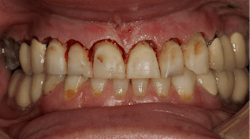South African toothbrush tree yields antibiotic to treat tuberculosis in a new way
The South African "toothbrush tree" is defined as a glabrous or pubescent evergreen shrub or tree of the genus Salvadora; twigs are fibrous and in some parts of the world are bound together in clusters and used as a toothbrush.
Salvadora persica (toothbrush tree). Source: J.M. Garg/Wikipedia In traditional medicine, the tree's antibacterial properties are used for oral health and to treat a variety of medical issues such as bronchitis, pleurisy, and venereal disease. Now, researchers are focusing on a particular compound from the toothbrush tree, called diospyrin, that inactivates a drug target for tuberculosis in a previously unseen way.RELATED INFORMATION ...Fighting bioburden with antimicrobial textiles in dental uniforms"OUCH!!! — I Just Got Stuck"TB is short for Mycobacterium tuberculosisAntibiotics. Why don’t they kill us too? Studies on diospyrin and related naphthoquinone compounds are being conducted as part of the efforts of a consortium of European researchers, More Medicines For Tuberculosis (MM4TB), throughout Europe who are dedicated to the development of new drugs for tuberculosis.Read the original article from ScienceDaily.



